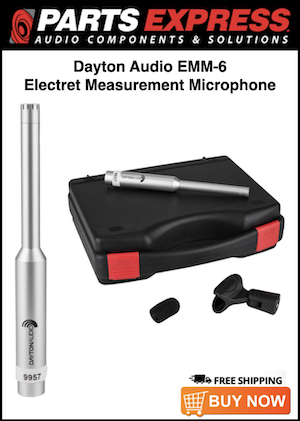In my last DIY speaker setup in a fully treated room that was right on the verge of being to dead and sounded superb. I placed the mic at the MLP for REW and a HTS member tuned my DIY speakers. In my current room which is NOT fully treated, and is a huge concrete room with some room treatment panels, and some large rugs (nowhere near enough due to the 32' tall ceilings and open floor plan), I am not sure what the differences would be tuning one way vs the other. I know most people I know tune from 1 meter, but my rational on doing it last time was that if I tune from the MLP it would be more relevant (due to that is where my head is)...it def is easier as the mic stays in the same position and is just rotated toward the speaker.. Anyone here that can assist me in which way would be best in a live sounding room?
-
AUDIO VIDEO PROCESSING, SETUP & ENVIRONMENTOfficial REW (Room EQ Wizard) Support Forum Audiolense User Forum Calibration Equipment Auto-EQ Platforms / Immersive Audio Codecs Video Display Technologies / Calibration AV System Setup and Support Listening Room / Home Theater Build Projects Room Acoustics and Treatments AV Showcase Movies / Music / TV / Streaming
-
AUDIO VIDEO DISCUSSION / EQUIPMENTHome Theater / Audio and Video - Misc Topics Essence For Hi Res Audio AV Equipment Advice and Pricing Awesome Deals and Budget AV Equipment AV Receivers / Processors / Amps UHD / Blu-ray / CD Players / Streaming Devices Two Channel Hi-Fi Equipment DIY Audio Projects Computer Systems - HTPC / Gaming HD and UHD Flat Screen Displays Projectors and Projection Screens AV Accessories Buy - Sell - Trade
Navigation
Install the app
How to install the app on iOS
Follow along with the video below to see how to install our site as a web app on your home screen.
Note: This feature may not be available in some browsers.
More options
You are using an out of date browser. It may not display this or other websites correctly.
You should upgrade or use an alternative browser.
You should upgrade or use an alternative browser.
Which is better...tune speakers from the MLP or from 1 Meter on a DIY speaker when starting from scratch on the crossover settings?
- Thread starter NBPK402
- Start date
ddude003
Senior AV Addict
More
- Preamp, Processor or Receiver
- PrimaLuna Dialogue Premium TubePre (2 channel+sub)
- Main Amp
- McIntosh MC152 SS Amp (2 channel)
- Additional Amp
- Yamaha RX-A850 Pro (the other 5 channels lol)
- DAC
- Chord Electronics Ltd. Qutest
- Computer Audio
- MacBook Pro, Custom i7 7700k De-lid 2xAsus1080ti GFX, Audirvana Studio, Hang Loose Convolver, Tone Projects Michelangelo, Pulsar Massive & 8200, LiquidSonics, SoX
- Universal / Blu-ray / CD Player
- Sony UBP-X700 /M Ultra HD 4K HDR & PS5
- Streaming Equipment
- Netgear Nighthawk S8000 Streaming Switch
Lumin U1 Mini Streamer Transport
- Streaming Subscriptions
- QoBuz Studio Premier, Amazon Prime & Netflix
- Front Speakers
- Martin Logan ElectroMotion ESL
- Center Channel Speaker
- Martin Logan Motion C2
- Surround Speakers
- Martin Logan Motion 4
- Surround Back Speakers
- Martin Logan Motion 4 (yes, another set of these)
- Subwoofers
- SVS SB-1000 Pro
- Screen
- Elite Screens Aeon CLR3 0.8 Gain 103-inch
- Video Display Device
- Samsung The Premiere LSP7T UST Laser Projector
- Remote Control
- PrimaLuna, Lumin iApp, Samsung & Yamaha
- Other Equipment
- Cifte 12AU7 NOS & Genalex Gold Lion Tubes in Pre
ThrowRug, SaddleBlankets, WideBand & Bass Traps...
You are doing Room Correction, yea? For 2 channel stereo or 2.1, I would go with the MLP... For HT, several samples averaged from across a listening area like an entire couch or the most often seating arrangement for multiple listeners... Other than time, there is nothing stopping you from trying several methods...
What I am doing is using REW to get my crossover settings...not tune the room. I will be using Dirac to tune the room. I need to learn how to use the auto tune function in REW as I have heard it does a great job, without having to know a lot about tuning.You are doing Room Correction, yea? For 2 channel stereo or 2.1, I would go with the MLP... For HT, several samples averaged from across a listening area like an entire couch or the most often seating arrangement for multiple listeners... Other than time, there is nothing stopping you from trying several methods...
Last edited:
skid00
Member
- Joined
- Mar 20, 2020
- Posts
- 127
More
- Main Amp
- 2 x Adcom GFA 555
- Front Speakers
- Carver Amazing Platinum Mark IV
You can be reasonably successful in EQing bass frequencies, when using the 'moving microphone method' - at the listening position.
Trying to EQ higher frequencies is problematic, due to room reflections and the speakers side/back panel emissions. Taking those at 1 meter would help eliminate reflections - if you also use narrow 'windows' in REW.
It isn't easy to blend LP and near-field measurements, given the differences in volume near vs. far. It never hurts to try, but you want to EQ using large values of Q (over larger swaths of frequencies).
Some people frown on using REW as a tone control. *I* think it works great that way. I've posted before on having multiple EQ files for use in eqAPO, if you would care to look at my prior posts.
*I* think it works great that way. I've posted before on having multiple EQ files for use in eqAPO, if you would care to look at my prior posts.
Don't be afraid to take your time doing scans. Oh-and I found it very useful to have an open-cell foam block to embed the mic in, to reduce reflections from the mic, and things behind it.
Trying to EQ higher frequencies is problematic, due to room reflections and the speakers side/back panel emissions. Taking those at 1 meter would help eliminate reflections - if you also use narrow 'windows' in REW.
It isn't easy to blend LP and near-field measurements, given the differences in volume near vs. far. It never hurts to try, but you want to EQ using large values of Q (over larger swaths of frequencies).
Some people frown on using REW as a tone control.
Don't be afraid to take your time doing scans. Oh-and I found it very useful to have an open-cell foam block to embed the mic in, to reduce reflections from the mic, and things behind it.
Thanks, the speakers are a DIY 2 way horn with an Xilica active crossover, so this is a scratch start tune. I am going to try the autotune feature if i can figure it out.You can be reasonably successful in EQing bass frequencies, when using the 'moving microphone method' - at the listening position.
Trying to EQ higher frequencies is problematic, due to room reflections and the speakers side/back panel emissions. Taking those at 1 meter would help eliminate reflections - if you also use narrow 'windows' in REW.
It isn't easy to blend LP and near-field measurements, given the differences in volume near vs. far. It never hurts to try, but you want to EQ using large values of Q (over larger swaths of frequencies).
Some people frown on using REW as a tone control.*I* think it works great that way. I've posted before on having multiple EQ files for use in eqAPO, if you would care to look at my prior posts.
Don't be afraid to take your time doing scans. Oh-and I found it very useful to have an open-cell foam block to embed the mic in, to reduce reflections from the mic, and things behind it.
ddude003
Senior AV Addict
More
- Preamp, Processor or Receiver
- PrimaLuna Dialogue Premium TubePre (2 channel+sub)
- Main Amp
- McIntosh MC152 SS Amp (2 channel)
- Additional Amp
- Yamaha RX-A850 Pro (the other 5 channels lol)
- DAC
- Chord Electronics Ltd. Qutest
- Computer Audio
- MacBook Pro, Custom i7 7700k De-lid 2xAsus1080ti GFX, Audirvana Studio, Hang Loose Convolver, Tone Projects Michelangelo, Pulsar Massive & 8200, LiquidSonics, SoX
- Universal / Blu-ray / CD Player
- Sony UBP-X700 /M Ultra HD 4K HDR & PS5
- Streaming Equipment
- Netgear Nighthawk S8000 Streaming Switch
Lumin U1 Mini Streamer Transport
- Streaming Subscriptions
- QoBuz Studio Premier, Amazon Prime & Netflix
- Front Speakers
- Martin Logan ElectroMotion ESL
- Center Channel Speaker
- Martin Logan Motion C2
- Surround Speakers
- Martin Logan Motion 4
- Surround Back Speakers
- Martin Logan Motion 4 (yes, another set of these)
- Subwoofers
- SVS SB-1000 Pro
- Screen
- Elite Screens Aeon CLR3 0.8 Gain 103-inch
- Video Display Device
- Samsung The Premiere LSP7T UST Laser Projector
- Remote Control
- PrimaLuna, Lumin iApp, Samsung & Yamaha
- Other Equipment
- Cifte 12AU7 NOS & Genalex Gold Lion Tubes in Pre
ThrowRug, SaddleBlankets, WideBand & Bass Traps...
Oh, did not realize you are doing active crossovers with Xilica kit... Did I miss that in your More or Sig??? Well that's a fine kettle of fish... 
 LOL...
LOL...

 LOL...
LOL...Oops, I thought the Xilica was in my signature, I will add it.Oh, did not realize you are doing active crossovers with Xilica kit... Did I miss that in your More or Sig??? Well that's a fine kettle of fish...LOL...
Thank you, I will return to tuning the speakers from the mlp.People measure at 1m when building a speaker that will be for a generic room.
The beauty of DIY is that you can select the parts you want, and tune the set to your listening position, as they will be for your room and your listening preferences.
Popular tags
20th century fox
4k blu-ray
4k uhd
4k ultrahd
action
adventure
animated
animation
bass
blu-ray
calibration
comedy
comics
denon
dirac
dirac live
disney
dolby atmos
drama
fantasy
hdmi 2.1
home theater
horror
kaleidescape
klipsch
lionsgate
marantz
movies
onkyo
paramount
pioneer
rew
romance
sci-fi
scream factory
shout factory
sony
stormaudio
subwoofer
svs
terror
thriller
uhd
ultrahd
ultrahd 4k
universal
value electronics
warner
warner brothers
well go usa







